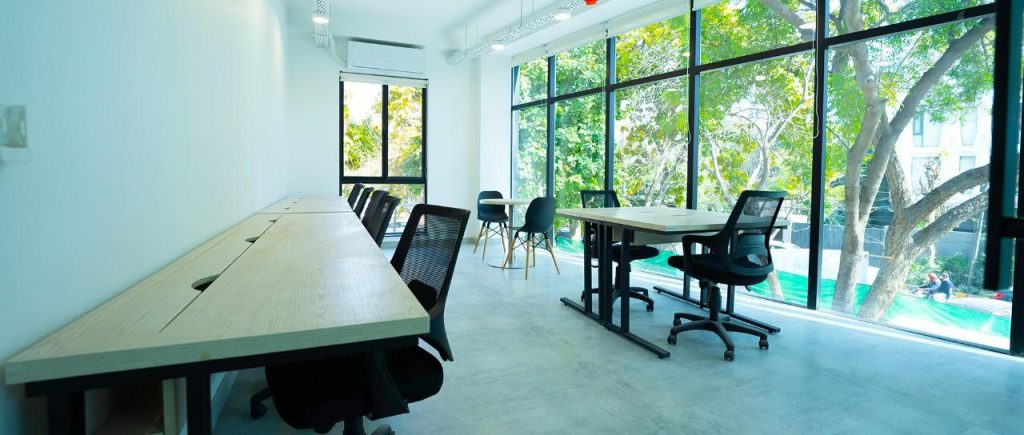Flexibility at work: The critical role of flexible offices in workplace strategies
Flexibility at work goes a long way toward optimizing the work culture. Post-pandemic dynamics convinced employers to think of alternative solutions to traditional office setups. This resulted in adopting a flexible work environment where employees are provided with variety and diversity in their work activities.
What is a Flexible Office?
A flexible office is a type of shared office space that offers multiple options for carrying out work and for design and arrangement. It is also popularly known as a flexispace.
Contrary to traditional office workspaces, flexible offices offer different desk arrangements for employees to carry out the work assigned at the moment.

There are following types of flexible offices that exist:
● Hot desks (Flexible desk)
● Coworking space
● Open offices
Hot Desks Or Flexible Desk
This arrangement includes non-fixed flexible desks, which employees can use individually.
Coworking Space
This shared office space arrangement includes employees from different companies working collaboratively.
Open Offices
This seating arrangement includes employees from different departments working together.
What is Flexible Working?
Flexible working is the term for any work arrangement that falls outside the scope of a traditional 9-5 office. The setup can be remote, work from home, or share an office space with other professionals. Flexible-working employees are generally happier and more productive than their office-bound counterparts. The flexibility to choose when, where, and how to work significantly increases employee performance and business outcomes.
One of the benefits of flexible workspaces is that they can be rearranged according to changing business requirements. You can scale them to accommodate team expansion and new projects. Such offices provide employees with the necessary freedom to work when, how, and where they want to.
Some of the prominent features of flexible coworking spaces are:
● Open-plan Interior
● Quiet areas
● Shared facilities

1. Open-Plan Designs
Open-plan offices first appeared a century ago in New York and gained popularity in 1960. However, they are now predominantly used in shared offices and coworking spaces. The concept originated from designers who wanted to accommodate large teams in the space provided. The open-ended space lets employees from different departments collaborate freely without any walls.
2. Quiet Areas
One drawback of open-plan spaces is that they are noisy. In a flexible office environment, this can be compensated by providing employees with quiet places and sound-proof phone booths.
3. Shared Facilities
Flexible workspace comes with shared amenities, which are cost-effective and convenient for professionals.
Benefits of Flexible Offices
Following are some of the prominent benefits of these flexible workspaces:
1. Enhanced Focus and Productivity
Employees tend to be more focused and productive in a shared office space. The reason? The ability to engage with other employees, hold meetings in privacy, and have a dedicated space for attending online meetings and webinars helps them execute tasks much more efficiently. Flexispace accommodates different work preferences and styles, empowering professionals in the best way possible.
2. Adaptability
A flexible work setting allows you to adapt to changes in workforce and seating arrangements. Whether you need to accommodate growing team members, support inter-department collaboration, or brainstorm with coworkers, a flexible coworking space covers all your needs.
The adaptable nature of the work allows you to meet business objectives by reducing costs and optimizing the workspace.
3. Agility and Accessibility
As business demands change, a shift in the seating arrangement helps accommodate the current situation. Whether you want to expand your team or take on a new project that demands collaboration with external partners, a Flexible workspace lets you quickly adapt to fluctuating needs. It makes the workspace more accessible and agile, resulting in a productive work culture.

4. Employee well-being
Flexible office environments help with productivity and creativity, but what about employees’ well-being? How does flexible working relate to that? Having options to choose between a chatty or quiet place impacts the employee’s mind positively. One can choose to either sit beside his best working pal or spend time working at a quieter place to complete the work quickly.
The ability to choose empowers individuals to give their best at work. Flexibility fosters an environment of peace and satisfaction among employees, positively impacting their well-being.
5. Collaboration and Creativity
Brainstorming ideas with your colleagues and figuring out solutions to pressing problems becomes a cup of tea in a collaborative work culture. Professionals from diverse backgrounds and different skill sets bring their unique perspectives to the table, creating an influx of creativity. This results in innovation and business growth.
Coworking Space Near Me – QuickOffice
If you are looking for a flexible coworking space near me option, QuickOffice is your go-to partner. We provide hot desks, open-ended offices, and shared office space tailored to your unique needs. Discover what we offer by exploring our website.
Conclusion
Businesses of all types have gravitated towards flexible office and work options due to their adaptability and agility. Hybrid work is the new norm, and companies are adopting this work model to cater to the demands of post-COVID work. Flexible and shared office space gives you the freedom to choose the office arrangement according to your work style and preferences. You decide the when, how, and where factor that keeps you motivated in your professional career.

